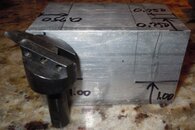I suspect the old silicone packing will hold up much better against water. It really is thick. You could always use a bead of Christolube at the head and stem of the piston and silicone for the main filler.
I think the groove is important to provide space for the 0.1+ cu inches of packing material that has to go somewhere when the piston moves from the fully open to the locked up position. I wonder if Herman could mill a groove into a mk5 ambient chamber.
I don't think milling a groove into the MK5 body is needed. I have an idea I'll try in the next week or so.
As for boot material: Silicone packing and silicone elastomer aren't compatible. How about using a non-silicone packing compound (such as christolube) to avoid the in-compatibility. The silicone elastomer is easy to cast and inexpensive...




